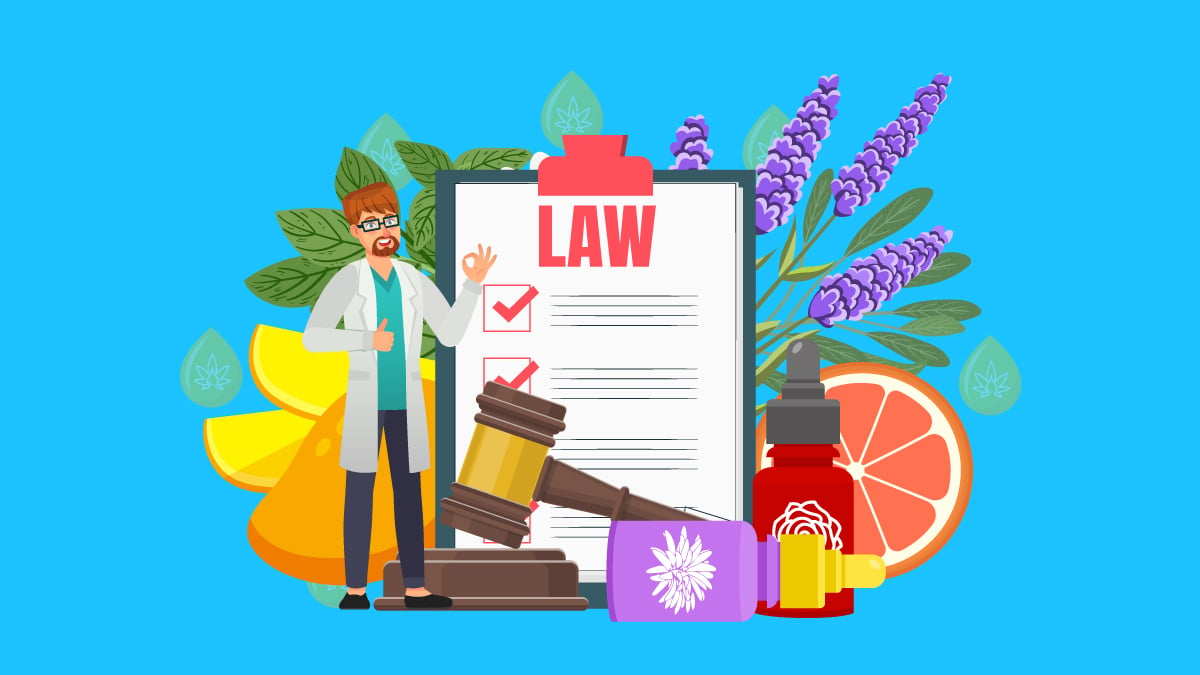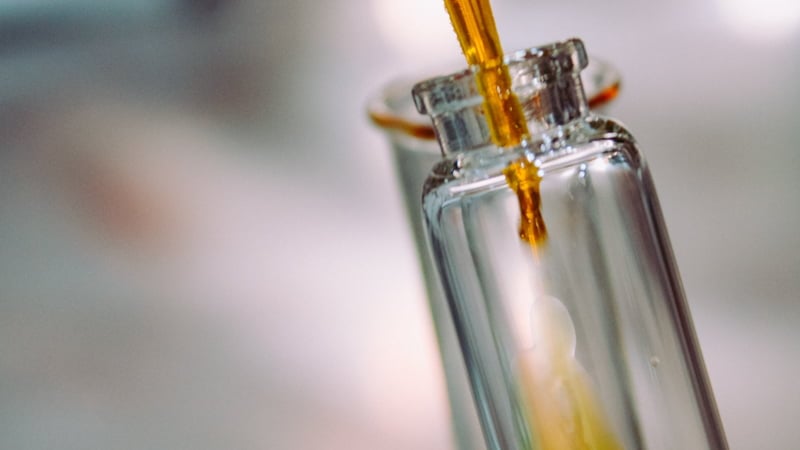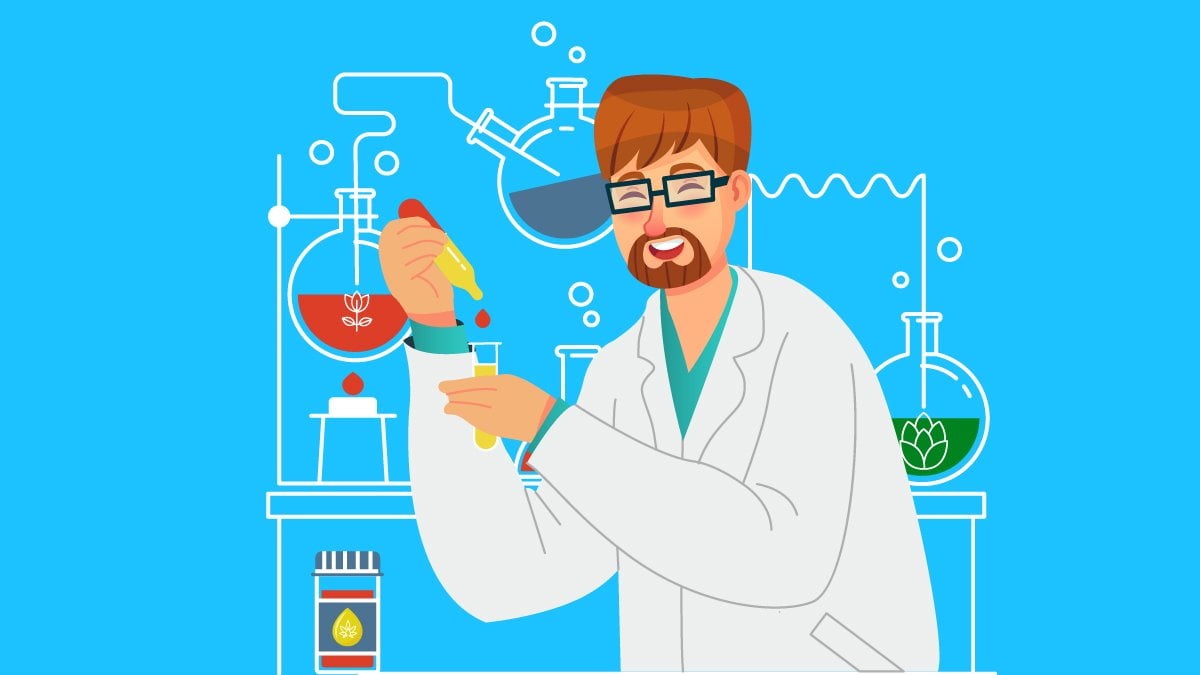Are Terpenes Legal?

You can buy just about any cannabis product today with added terpenes.
These terpenes can enhance or mitigate the effects of your cannabinoids. They’re popular with CBD or delta 8 THC users for their ability to enhance both the flavor and effect profiles of these formulas.
However, since they can come from cannabis, many people wonder whether terpenes are legal in all 50 states.
The short answer to this question is yes, terpenes are fully legal and available to purchase online in the United States, but you should know a few things.
Are Terpenes Legal?
Terpenes are entirely legal in the United States because they don’t contain any THC. The molecular structure has nothing to do with cannabinoids other than the fact that they’re produced in the same plant (Cannabis sativa).
Terpenes are also found throughout the plant kingdom in herbs like lavender, tea tree, nutmeg, and more.
As long as a terpene extract doesn’t contain any THC, it’s entirely legal in the US. Here, terpenes are regulated as a food supplement rather than a cannabis extract — but only if they’re pure.
What is A Terpene, Exactly?
A terpene is a chemical compound. It’s described by the formula (C5H8)n, and scientists classify them based on the number of carbons. Some are isomers, meaning they are the same as another terpene, just with a molecule in a slightly different location or position.
You may be just hearing about these chemicals, but they have been around you all your life.
When you smell lavender, you smell the terpenes linalool, myrcene, and pinene predominantly.
When you smell an orange peel, you’re smelling limonene for the most part, with some pinene cymene, terpinene, and myrcene.
It’s important here to note that modern people have scoffed at aromatherapy for a long time, but terpene research reveals that it may have some therapeutic value.
Johns Hopkins Medicine posted an article on their website in support of aromatherapy, with different ways to use it and a few cautions to keep in mind.
A Brief History of Terpenes
Humans have used terpenes for millennia. Also known as essential oils, these compounds are produced by many plants and some animals (mostly insects).
Terpenes serve as a defense for the organism, a sexual attractant, a means of communication, a way of eliminating competition for space, and may even help induce rain.
For humans, these compounds serve many purposes. The first thing we notice about terpenes is the fragrance. They are responsible for everything from the smell of flowers and trees to the objectionable odors of some insects and plants. Aromatherapists have used these in various ways as essential oils since before 3500 BCE.
Scientists minted the term “terpene” in 1866, the word derived from the Greek name for the terebinth tree. This tree produces resins that are extremely high in terpenes. These resins were popular throughout the Middle East. Although the fragrances were the first things that attracted science to terpenes, we now know they may have many benefits for humans. It has only been in the last 30 to 40 years that extensive studies have been done on them, and there is still much more work owing — an iceberg tip comes to mind.
Their recent popularity is due to the legal cannabis explosion. We can now extract these compounds from the cannabis plants (including hemp) from other plants, animals and insects, and labs producing synthetic versions.
Where Do Terpene Extracts Come From?
One of the first things you should know is that you eat them all the time. Think about β-carotene, the terpene that gives the carrot its color.
Our bodies metabolize that into vitamin A, which we need to survive. You also smell them all the time. Even if you don’t have any flowers around, check out your cup of tea. Terpenes are responsible for much of the flavor in a cup of tea (green, black, oolong, and herbal).
To use terpenes straight is another matter. Extracted terpenes are highly concentrated and are thought to support many of our bodily functions. For instance, a recent study showed lavender oil, high in linalool, as possibly offering help with wound healing (1).
Here are some ways we are isolating terpenes for human use:
Cannabis-Derived Terpenes
Cannabis is very high in some terpenes. Myrcene, limonene, linalool, caryophyllene, and pinene are the top five terpenes found in most cannabis plants. The combinations of terpenes in the plant create the “terpene profile,” which then helps growers characterize and name the strain.
Non-Cannabis Derived Terpenes (Botanical Terpenes)
As we said, every plant contains terpenes. That makes it easy to find them, and companies use various processes to extract them. Steam and hydro-distillation are widely considered the best choice to avoid the use of potentially harmful chemicals.
Synthetic Terpenes
Plants do not make synthetic terpenes. They are made in a laboratory. Although one can argue that quality and strength can be more accurately regulated in a lab, the processing and packaging are big unknowns.
Note: Finest Labs does not use any synthetic terpenes in any product offered on our website.
What Do People Use Terpenes For?
Even people who don’t think they use terpenes use them constantly, every day. Here are just a few ways botanical and synthetic terpenes make their way into your life.
CBD & Other Cannabis Extract Formulas
A common application of terpenes is to boost the effect profile and flavor of other health supplements. This is especially common in the cannabis space — including CBD oils, delta 8 vape carts, and much more.
Terpenes can also be blended to recreate the aromatic profile of popular cannabis strains.
For example, strains like Grape Ape are high in terpenes like myrcene and beta-caryophyllene, while other strains, such as Green Crack, are high in limonene and beta-pinene.
By blending the terpenes associated with each strain, we can recreate the aromatic profiles of popular cannabis strains. This is useful for adding these flavors to vape pens or CBD tinctures without having to use the marijuana flower to make them (which would make them illegal or restricted).
Body Products
Terpenes make up a large part of cleansing, soothing, and cosmetic body products. Linalool is one of the most popular because it is thought to aid wound healing — this makes it a perfect addition to a shaving routine!
Soaps are often lavender-scented, which means there is plenty of linalool and the other terpenes mentioned above if it’s scented with essential oils (not fragrance oils). Any soap that has an essential oil listed as an ingredient will have terpenes.
Note that fragrance oils are not the same thing as essential oils. All essential oils are terpene-based because they are derived from plants, but fragrance oils are not necessarily terpenes.
Cleaning Products
Citrus-based cleaners are the most prevalent cleaners available with terpenes. Lemon Pledge, Angry Orange, LA’s Totally Awesome, Finish Line Bike Degreaser, and CitraSolv are just small samples. In fact, they are so prevalent that the United States Department of Agriculture has put out a Tech Tips sheet on them to help people avoid the corrosion that can come with these strong cleaners.
Other cleaners that contain terpenes are Pine-Sol (pinene), many personal hygiene products (linalool), and CirtuSolution Carpet Cleaning products (limonene). One thing to remember when using terpenes as cleaning agents is they are volatile — avoid open flames.
What Are The Benefits of Terpenes?
Every terpene is different. Just as each one has its own unique aroma, it also has a unique set of benefits.
Let’s cover some of the most popular terpenes used today and explore some of the benefits for each one.
1. Limonene
This terpene is the citrusy terpene mentioned above and is found in the rind of citrus fruits, especially orange peels.
Aromatherapists use it for inflammation, stress, and oxidative damage. This terpene may also reduce appetite. Scientists are studying this terpene heavily for its possible value in relieving indigestion and reflux and may help protect cells against damage by chemotherapy (2).
2. Pinene
Who doesn’t like to wake up in the morning to the crisp smell of the pine tree? Well, that’s pinene for you! Always ready for an invigorating walk with you in the woods. Found in pine trees, frankincense, juniper berries, and cypress, this fascinating terpene is prized by aromatherapists for respiratory and immune support.
3. Myrcene
Need a good lullaby sometimes? Aromatherapists would tell you to try essential oils containing myrcene. Early studies have shown a sedative effect found in high concentrations in cannabis, hops, and mangoes. Some also claim anti-inflammatory response, antibiotic properties, and antimutagenic attributes in myrcene.
4. Linalool
This lovely terpene is found in hundreds of plants and, most specifically, in lavender. It is thought that it’s prevalent enough that we eat around a tenth of an ounce annually in our food. Aromatherapists use anti-inflammatory, analgesic, stress reducer, mosquito repellent, mild sedative, and anti-epileptic.
5. Humulene
So far, the terpenes we’ve discussed are relaxing. Still, humulene — common hops, ginseng, and sage — was found in a recent study to have anti-inflammatory effects (topical and systemic), protective properties against chemotherapy, and may help heal wounds (3).
These five terpenes are an incredibly small sample of terpenes that aromatherapists use daily. If you’re interested in pursuing more information on aromatherapy and terpenes, there’s a ton of information online. You can also consult with an alternative medicine specialist for more specific insight into your constitution.
Summary: Are Terpenes Legal or Not?
Well, it’s complicated but not inscrutable. The first thing to remember is that essential oils aren’t derived from cannabis, so they are legal.
Here are the three terpene sources and their legality:
- Terpenes derived from cannabis are only legal in states where marijuana is legal. For states where cannabis is not legal, you need to use non-cannabis (botanical) or synthetic terpenes.
- Non-cannabis botanical terpenes are legal in all 50 states, and all plant-based terpenes can be extracted from non-cannabis plants. This includes hemp that is less than .03% THC if hemp is legal in your state.
- Synthetic terpenes are also legal but questionable in how they react with our bodies.
Even if you do not live in a state where cannabis is legal, terpenes and their applications are absolutely fascinating. As with anything new on the science platform, much more research is warranted. These compounds could bring so much healing to humanity that to ignore them would be a blasphemy to scientific inquiry.
All that said, when you’re ready to experiment with terpenes in your products, including your cannabis products, read all the reliable literature you can get your hands on so you know the risks and rewards. Don’t just listen to your friend’s wife’s uncle’s best friend’s kid, and make sure you get the info from a reliable source. Nothing can replace research except high-quality research.




